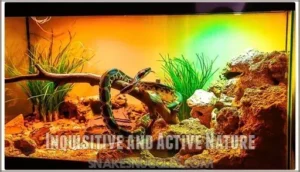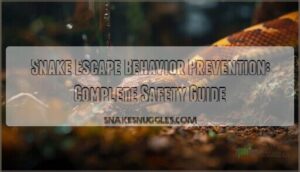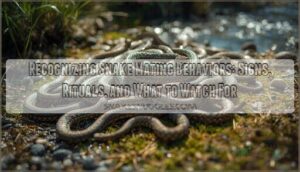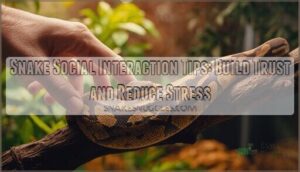This site is supported by our readers. We may earn a commission, at no cost to you, if you purchase through links.

You won’t find vague "pros and cons" here. Instead, you’ll get specific insights into feeding logistics, health vulnerabilities, social friction, and behavioral limitations that determine whether a corn snake actually fits your life. Understanding these ten concrete factors helps you make a decision grounded in biology and practical reality, not pet store marketing or online myths.
Table Of Contents
- Key Takeaways
- Docile and Easy to Handle
- Inquisitive and Active Nature
- Minimal Biting Risk
- Safe Around Children (Supervised)
- Simple Care Requirements
- Longevity and Lifespan
- Feeding and Dietary Needs
- Potential Health Concerns
- Social Perception and Acceptance
- Compatibility With Lifestyle
- Frequently Asked Questions (FAQs)
- What are the cons of owning a corn snake?
- What is the biggest trouble with corn snakes as pets?
- What are the benefits of owning a corn snake?
- Are corn snakes good or bad?
- What are the cons of snakes?
- How often do corn snakes need to be handled?
- Can corn snakes be housed together in one enclosure?
- What size prey items are appropriate for different ages?
- Are there any legal restrictions on owning corn snakes?
- What permits or licenses do corn snakes require?
- Conclusion
Key Takeaways
- Corn snakes are genuinely docile and manageable, making them suitable for first-time reptile owners, but they require a 15-20 year commitment with consistent feeding schedules, proper temperature and humidity control, and specialized frozen prey that many owners underestimate when making adoption decisions.
- These snakes don’t bond with humans or learn tricks like traditional pets—they tolerate handling through instinct rather than affection, which means you’re choosing a low-interaction companion that won’t respond to training or provide emotional reciprocity.
- Health vulnerabilities like respiratory infections, shedding complications from improper humidity, and parasites such as Cryptosporidium require vigilant monitoring and can lead to costly veterinary care, while rehoming proves nearly impossible due to overwhelmed rescues and limited adoption networks.
- Social stigma remains a significant challenge, with roughly half of Americans experiencing snake-related fear or discomfort, forcing owners to regularly educate guests and manage negative reactions that complicate household dynamics and social gatherings.
Docile and Easy to Handle
If you’re looking for a pet that won’t put up a fight when you reach into its enclosure, corn snakes are about as cooperative as reptiles get. Their docile temperament isn’t just a fluke—it’s hardwired into their nature. These snakes tolerate touch remarkably well, rarely showing defensive behavior when approached with proper animal interaction techniques.
You won’t need complicated snake socialization strategies or extensive temperament testing; their gentle nature shines through from the start. With consistent, calm interactions, corn snakes develop trust quickly, making them ideal pet snakes for beginners and experienced keepers alike.
That calm behavior translates into stress-free care, giving you confidence every time you interact with your scaly companion.
Inquisitive and Active Nature
While their easygoing temperament makes corn snakes simple to manage, their inquisitive and active nature adds a whole new layer of interest to their care. These pet snakes display impressive snake intelligence through constant active exploration of their surroundings. You’ll notice curious behavior as they investigate every corner, object, and texture within reach—a reflection of their rich behavioral traits.
Environmental enrichment isn’t optional; it’s essential for meeting their needs:
- Climbing branches satisfy their instinct to perch and survey territory
- Multiple hides create security while encouraging natural burrowing patterns
- Textured surfaces stimulate tactile exploration and aid shedding
- Rearranged decor prevents monotony and challenges their spatial memory
- Regular management builds management trust and mental engagement
This combination of animal behavior and intelligence makes corn snakes endlessly entertaining to observe. Their snake behavior reveals a species that thrives on interaction with their environment, not just passive existence within it.
Minimal Biting Risk
One of the biggest concerns for first-time snake owners—biting—becomes almost irrelevant with corn snakes, as these reptiles show striking restraint even during routine manipulation. Their docile nature translates into outstanding manipulation trust, a trait that develops quickly with consistent, gentle manipulation. Unlike defensive species that strike when startled, corn snakes typically signal discomfort through body language—giving you time to adjust your animal manipulation techniques before escalation occurs.
Understanding snake behavior and health helps you identify rare risk factors that might trigger defensive reactions:
| Situation | Corn Snake Response | Safety Measures |
|---|---|---|
| Feeding time | May mistake hand for prey | Use tongs; manipulate hours after meals |
| Shedding cycle | Temporarily vision-impaired | Minimize contact during cloudy eyes |
| Startled/threatened | Defensive musking, not biting | Approach slowly with visible movements |
| Illness/injury | Uncharacteristic aggression | Monitor health; consult veterinarian |
This predictable snake behavior makes bite prevention straightforward—respect their space during vulnerable moments, and they’ll respect your fingers during everything else.
Safe Around Children (Supervised)
That same bite-averse temperament makes corn snakes surprisingly appropriate companions for supervised children, transforming what many parents assume is a risky pet into a gentle teaching tool about responsibility and living creatures. Their predictable snake behavior and health patterns allow you to introduce kid-friendly pets without the unpredictability of mammals that might nip when overstimulated.
Child safety tips for supervised interactions with family reptiles:
- Always supervise children under 12 during touch trust building sessions
- Teach gentle touch—supporting the body, never squeezing or grabbing
- Wash hands before and after contact to prevent contamination
- Limit sessions to 10-15 minutes to prevent stress for both child and snake
- Practice animal touch techniques like recognizing stress signals (rigid posture, rapid tongue flicks)
This structured approach to pet snake care builds confidence while respecting the animal’s boundaries—corn snakes won’t tolerate rough treatment, but they’ll reward patience with calm cooperation.
Simple Care Requirements
One of corn snake ownership’s biggest advantages is that these reptiles don’t demand complicated care routines or expensive equipment. Their needs are straightforward and manageable, even if you’re balancing a busy schedule.
Let’s break down three key aspects that make corn snakes refreshingly simple to care for.
Manageable Size
If you’re worried about wrestling with a boa-sized beast in your living room, don’t be—corn snakes stay refreshingly compact throughout their lives. Adults usually reach 3 to 5 feet, making them easy to manage without specialized techniques.
Space requirements remain modest: a standard 20-gallon enclosure comfortably houses most adults. Growth rates are gradual, so you won’t face sudden size jumps requiring frequent upgrades to your setup.
Affordable Cost
Unlike car payments that never seem to end, the upfront cost of a corn snake won’t drain your savings—most specimens range from $30 to $150, and a complete starter setup rarely exceeds $300.
Ongoing expenses stay manageable, too—frozen mice cost roughly $1 to $3 per meal, and with their small size and long lifespan, you’re looking at minimal food costs over decades of companionship without breaking your maintenance budget.
Low Maintenance
Corn snakes ask surprisingly little of you—weekly feeding schedules, spot-cleaning when needed, and temperature checks cover most of their routine care demands. Substrate options like aspen shavings simplify tank maintenance, while humidity control stays straightforward with occasional misting during sheds.
Their docile nature means minimal care requirements beyond basic housing costs, freeing you to enjoy these gentle pets without constant worry.
Longevity and Lifespan
Corn snakes can live 15 to 20 years in captivity, which means you’re signing up for a relationship that spans nearly two decades. This impressive lifespan is a double-edged sword—it offers years of companionship but also demands unwavering commitment through major life changes.
A corn snake’s 15-to-20-year lifespan means you’re committing to decades of care, not just a casual pet phase
Here’s what you need to think about regarding their longevity.
Potential for Long-Term Commitment
Choosing a corn snake means you’re signing up for decades, not just a few years. Their long lifespan—commonly 15 to 20 years, with some reaching over 30—demands serious owner preparation and responsible pet ownership.
Before committing to reptile ownership, consider these longterm commitment realities:
- You’ll manage over 1,000 weekly feedings and cleanings across 20 years of pet maintenance
- Your snake will likely outlive most dogs and cats you know
- Major life changes—college, moves, career shifts—will happen with your snake in tow
- Annual care costs accumulate to thousands over their longevity impacts
- Many younger owners underestimate the commitment challenges ahead
Understanding the corn snake care is essential for potential owners. This extended care responsibility separates reptile ownership from shorter-lived pets, so plan accordingly for the decades ahead.
Difficulty in Rehoming
When life circumstances shift, you might discover that rehoming a corn snake isn’t as simple as posting an ad and moving on. Reptile rescue organizations stay overwhelmed, adoption issues complicate placement, and many potential adopters lack proper reptile care knowledge.
Snake relocation demands responsible pet ownership—you can’t abandon your exotic pet maintenance duties when convenience fades. These rehoming challenges mean you’re basically locked into decades of reptile ownership, so plan accordingly before bringing home your pet snake.
Feeding and Dietary Needs
Feeding your corn snake isn’t complicated, but you need to understand what works and what doesn’t. The right food choices and feeding schedule keep your snake healthy without overcomplicating your routine.
Here’s what you should know about meeting your corn snake’s dietary needs.
Specialized Food Sources
Your corn snake won’t thrive on kibble or table scraps—this is a carnivore that requires whole prey items like mice or rats to meet its nutritional needs. You’ll source frozen or live food from reptile suppliers, ensuring proper nutrient balance through meal planning that matches your snake’s size.
These feeding techniques support ideal reptile care, though food supplements are rarely necessary when whole prey provides complete feeding and nutrition naturally.
Feeding Frequency
Once you’ve got the right prey item in your freezer, the rhythm of feeding becomes your next consideration—and getting the timing right matters just as much as the meal itself. Hatchlings need meals every 5-7 days, while adults thrive on weekly or biweekly feeding schedules.
Matching rodent size to your snake’s girth guarantees proper nutrition needs without overfeeding.
During shedding periods, don’t panic if your corn snake refuses food—appetite dips are normal, and consistent feeding techniques will keep your reptile husbandry on track.
Potential Health Concerns
While corn snakes are generally hardy, they’re not immune to health problems. Understanding common issues helps you spot warning signs early and take control of your snake’s well-being.
Here are the main health concerns you should watch for.
Shedding Issues
Shedding Problems don’t have to derail your snake care routine, but they’re something you need to monitor. Corn snakes shed every four to six weeks as juveniles and every two to three months as adults. When humidity control falls short—usually below 40-60%—you’ll see incomplete sheds, especially around the eyes or tail tip. Skin retention isn’t just cosmetic; it can lead to constriction injuries and infections if ignored.
- Young corn snakes shed more frequently than adults, so adjust shedding frequency expectations as your pet matures
- Low environmental moisture is the usual culprit behind shedding problems, making proper reptile husbandry essential
- Irregular or prolonged shedding cycles often point to deeper health implications in your corn snakes
Understanding the shedding process details is vital for maintaining your pet’s health.
Respiratory Problems
Poor humidity control and temperature drops set the stage for respiratory infections, which hit corn snakes harder than most owners expect. You’ll notice wheezing, mouth bubbles, or lethargy when breathing difficulties emerge.
Ferlavirus disease can escalate fast, causing mucous secretions and even sudden death. Bacterial coinfections often follow viral snake pneumonia, especially when stress weakens immunity—so keeping your habitat conditions stable isn’t optional.
Parasites and Infections
Beyond respiratory issues, parasites and infections demand vigilance through routine disease prevention checks. Cryptosporidium serpentis causes chronic gastritis, triggering regurgitation and anorexia that can prove fatal. Snake mites spread bacterial infections and fungal pathogens, while asymptomatic Salmonella risk threatens both you and your snake.
Watch for these warning signs:
- Regurgitation or appetite loss (Cryptosporidium)
- Skin irritation or visible mites (parasite control needed)
- Lethargy or unusual behavior (infection signs)
Regular vet screenings catch problems before stress turns hidden infections into serious threats.
Social Perception and Acceptance
Owning a corn snake means dealing with social realities that many reptile keepers face. Not everyone shares your enthusiasm for snakes, and you’ll quickly discover who feels comfortable around your pet and who doesn’t.
Here’s what you need to know about managing the social landscape of corn snake ownership.
Fear or Dislike of Snakes
Here’s an uncomfortable truth: roughly half of all Americans feel anxious around snakes, and about 51% report genuine fear—making snake phobia, or ophidiophobia, the most common animal-related fear in the country. This reptile aversion stems from cultural narratives, media sensationalism, and evolutionary fear psychology rather than actual danger.
Your corn snakes’ docile nature won’t automatically dissolve someone’s herpetophobia, but education about their gentle interaction and low risk can reshape perceptions. Responsible snake ownership paired with patient exposure helps guests understand these animals aren’t threats—they’re trustworthy companions deserving respect, not fear.
Negative Reactions From Guests
When you invite someone over, you don’t expect to explain why your pet won’t harm them—but with a corn snake resting in its vivarium, that conversation becomes unavoidable. Guest phobias and visitor anxiety about snake ownership can create household tensions that complicate social gatherings.
You’ll face social stigma surrounding exotic pets, requiring patience and animal management techniques demonstrations to ease concerns—even when your corn snake poses no actual threat to anyone present.
Compatibility With Lifestyle
Choosing a corn snake means weighing how they fit into your daily routine and long-term expectations. These snakes interact with their environment and tolerate touch, but they won’t bond with you or respond to training like traditional pets.
Understanding these behavioral realities helps you decide if a corn snake aligns with what you’re looking for in a companion animal.
Receptiveness to Human Interaction
If you’re expecting a corn snake to fetch your slippers or roll over on command, you’re setting yourself up for disappointment—but that doesn’t mean these reptiles are indifferent to your presence. Corn snakes demonstrate their docile nature through tolerating regular interaction sessions, and with proper interaction techniques and patience, you’ll notice they respond to movement and recognize feeding routines. Building interaction trust requires consistent socialization methods and understanding snake temperament through body language cues.
- Recognize curiosity when your snake actively explores during supervised interaction sessions
- Use gentle interaction techniques to build trust without triggering defensive responses
- Watch for relaxed body posture indicating comfort with human bonding
- Apply consistent interaction tips to strengthen your unique reptilian connection
Inability to Learn Tricks
Let’s be honest—training your corn snake to sit, stay, or shake isn’t happening, no matter how many YouTube tutorials you watch. These reptiles simply lack the cognitive abilities for trick training, unlike dogs or parrots.
Their behavioral patterns revolve around instinct rather than learned commands, creating natural learning barriers that no amount of patience can overcome.
Understanding these trainability limits helps you appreciate corn snakes for what they truly offer—calm companionship without performance expectations.
Frequently Asked Questions (FAQs)
What are the cons of owning a corn snake?
Owning a corn snake comes with challenges. Space requirements, veterinary costs for respiratory infections or parasites, and specialized equipment add up.
Escaped snakes cause stress, though these pets maintain low noise levels, making shedding problems and other health issues your primary concerns.
What is the biggest trouble with corn snakes as pets?
Their commitment spans decades, their care demands consistency, and their longevity creates responsibility. Corn snakes live 15-20 years, requiring stable space requirements, humidity control, and feeding challenges throughout their lifespan.
Veterinary costs, shedding problems, respiratory infections, and parasites compound the challenge, while escaped snakes add stress and rehoming becomes nearly impossible.
What are the benefits of owning a corn snake?
Corn snakes offer notable benefits: their gentle nature makes snake management easy, their small size suits compact vivarium design, and their stunning color variety provides attractive appearance options.
You’ll appreciate their pet affordability and reliability as reptile companionship, building management trust through their calm temperament.
Are corn snakes good or bad?
Think of reptile pet ownership as a balancing scale—corn snakes tip toward “good” when you master snake care and animal management techniques.
With proper reptile care, ethics considerations, and understanding of snake behavior, they’re rewarding companions. Animal welfare depends entirely on your commitment.
What are the cons of snakes?
Not all snake enthusiasts have nerves of steel regarding reptile pet ownership. Space requirements matter—corn snakes need proper enclosures with controlled heating. Snake escapes happen, and while there’s no venomous risk with corn snakes, managing stress affects their wellness. Parasites require vigilant care and maintenance.
How often do corn snakes need to be handled?
You don’t need constant contact to build trust—in fact, less is often more.
Interact with your corn snake 1-2 times weekly using gentle interaction and proper interaction techniques to maintain tameness and reduce stress without overwhelming them.
Can corn snakes be housed together in one enclosure?
You shouldn’t house corn snakes together. While vivarium setup might technically accommodate multiple snakes, they’re solitary by nature and cohabitation creates stress, feeding competition, and potential aggression.
Proper Snake Care and Maintenance means providing individual enclosures—prioritizing snake compatibility and safety over convenience.
What size prey items are appropriate for different ages?
Matching prey to your snake’s size isn’t rocket science—think ‘as wide as the widest part of your snake.’ Hatchlings start with newborn pinkies, juveniles graduate to fuzzies and hoppers, while adults manage adult mice comfortably.
Proper prey size guidelines prevent regurgitation and guarantee healthy snake growth.
Are there any legal restrictions on owning corn snakes?
Most regions don’t require permits for corn snakes, but ownership laws vary by location. Before bringing one home, check local exotic pet laws and snake registration requirements—some states restrict reptile ownership or mandate breeding regulations to support wildlife conservation efforts and animal welfare.
What permits or licenses do corn snakes require?
In most U.S. states, corn snakes don’t require permits or licenses—no red tape involved. However, local ordinances may impose breeding restrictions or snake registration requirements, so check your city’s exotic pet care regulations to verify responsible pet keeping.
Conclusion
Your decision rests on a simple truth: corn snakes don’t bend to fit your expectations—you adapt to theirs. These aren’t trainable companions or cuddly confidants. They’re low-maintenance carnivores that thrive under specific conditions and demand patience with frozen rodents, decades-long commitments, and judgmental relatives.
The 10 pros and cons of having a corn snake as a pet clarify whether you’re choosing freedom from daily demands or signing up for a relationship defined entirely by your willingness to meet biological non-negotiables on their terms, not yours.
- https://www.rspca.org.uk/adviceandwelfare/pets/other/cornsnake
- https://www.findlaw.com/injury/torts-and-personal-injuries/exotic-animal-laws-by-state.html
- https://wildsci.co.uk/blog/the-corn-snake-your-complete-uk-guide-to-this-fascinating-pet/
- https://reptilia.org/corn-snake/
- https://cosleyzoo.org/corn-snake/















